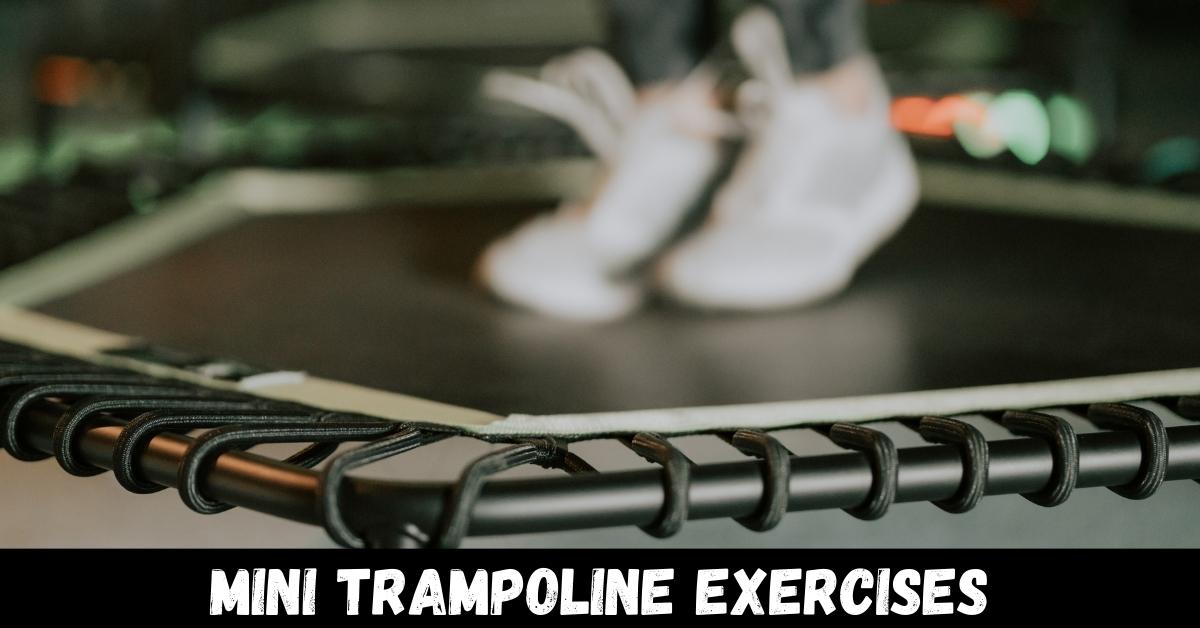I’m always on the lookout for new and exciting ways to stay active and challenge my body. One workout that has really caught my attention in recent years is mini trampoline exercises.
Also known as rebounding, this workout involves performing a variety of exercises on a small trampoline, which is designed to be low-impact and easy on the joints.
Mini trampoline exercises are not only fun and engaging, but they also offer a range of physical and mental health benefits, including improved cardiovascular health, weight loss, and stress reduction.
Whether you’re a beginner or an experienced fitness enthusiast, mini trampoline exercises can be a great addition to your workout routine.
In this article, I will provide a comprehensive guide to mini trampoline exercises, including their benefits, different types of mini trampolines, and exercises suitable for beginners, intermediate and advanced users. So, let’s jump in and explore the world of mini trampoline exercises!
Mini trampoline exercises: Mini trampoline exercises, also known as rebounding, involve performing a variety of low-impact exercises on a small trampoline. These exercises offer a range of physical and mental health benefits, including improved cardiovascular health, weight loss, and stress reduction.
Understanding Mini Trampoline Exercises
Mini trampoline exercises, also known as rebounding, are a fun and effective way to get in shape. They involve bouncing on a small trampoline, usually measuring around 3 feet in diameter, and can be done in the comfort of your own home.
These exercises are low-impact and provide numerous health benefits, making them a popular choice for people of all ages and fitness levels.
How Do Mini Trampoline Exercises Work?
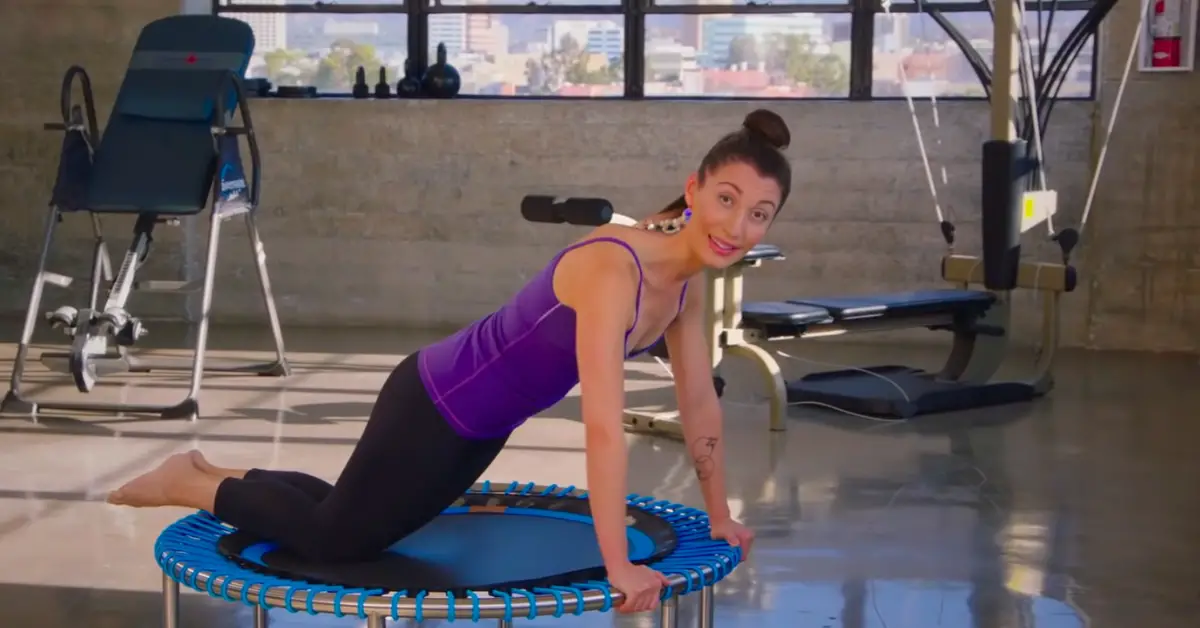
When you bounce on a mini trampoline, you create a gravitational pull that affects every cell in your body. This is because when you land on the trampoline, you experience a brief moment of weightlessness before the trampoline springs back, causing you to bounce back up.
This movement causes your body to undergo a series of changes, including an increase in blood flow, oxygenation, and lymphatic drainage.
One of the main benefits of mini trampoline exercises is that they provide a low-impact workout that is easy on your joints.
Unlike running or jumping on a hard surface, bouncing on a trampoline puts less stress on your knees, ankles, and hips, making it a great option for people who are recovering from an injury or suffer from joint pain.
Another benefit of mini trampoline exercises is that they can help improve your cardiovascular health. Bouncing on a trampoline gets your heart rate up and increases your circulation, which can help lower your risk of heart disease, stroke, and other cardiovascular conditions.
Finally, mini trampoline exercises can also help improve your balance, coordination, and overall fitness level. By bouncing on a trampoline, you engage your core muscles, which can help improve your balance and stability.
Additionally, mini trampoline exercises can help increase your endurance and stamina, making it easier to perform other physical activities.
Types of mini trampolines and their features
There are several different types of mini trampolines available on the market, each with its own set of features and benefits. Here are some of the most common types of mini trampolines:
Folding mini trampolines
Folding mini trampolines are a great option for people who want to save space. These trampolines can be folded up and stored away when not in use, making them ideal for small apartments or homes with limited storage space.
Additionally, folding mini trampolines are usually lightweight and easy to transport, so you can take them with you when you travel.
Non-folding mini trampolines
Non-folding mini trampolines are sturdier and more durable than folding trampolines. They are usually made with stronger materials and can support more weight.
However, they are also more difficult to store and transport, so they are better suited for people who have a dedicated workout space in their homes.
Fitness rebounders
Fitness rebounders are mini trampolines that are specifically designed for exercise. They usually come with resistance bands or weights that can be attached to the trampoline, allowing you to perform a variety of exercises that target different muscle groups.
Fitness rebounders are a great option for people who want to get a full-body workout on their mini trampoline.
Bungee trampolines
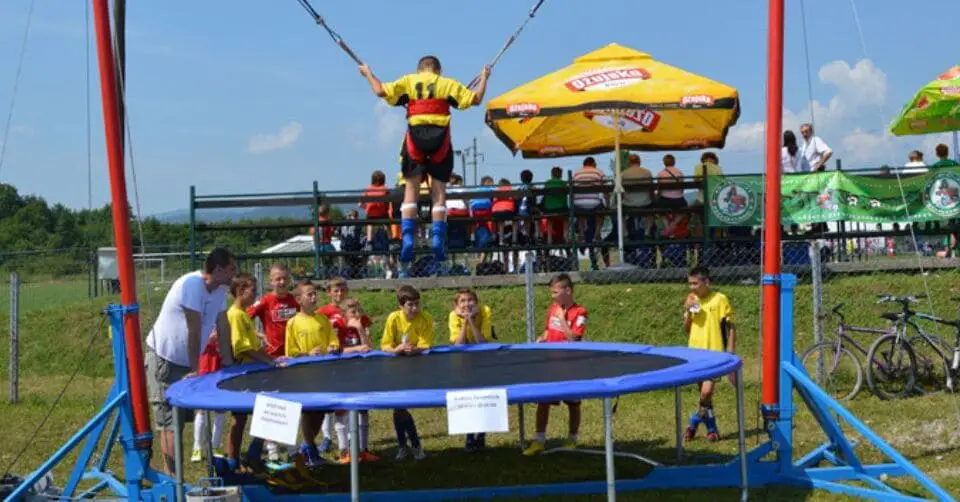
Bungee trampolines are mini trampolines that use bungee cords instead of springs. This design creates a smoother, more controlled bounce that is easier on your joints.
Bungee trampolines are a great option for people who want to do high-intensity exercises without putting too much stress on their knees and ankles.
Barre trampolines
Barre trampolines are mini trampolines that come with a stability bar that you can hold onto while you bounce. This design provides additional stability and support, making it easier for beginners to perform exercises on the trampoline.
Additionally, the stability bar can be used for balance exercises and stretching, making it a versatile piece of equipment.
When choosing a mini trampoline, it’s important to consider the size, weight capacity, and construction materials. You should also look for trampolines that come with safety features, such as a padded frame and non-slip feet, to reduce the risk of injury.
In addition to choosing the right type of mini trampoline, it’s important to follow proper safety guidelines when using the equipment.
Always warm up before exercising and start with low-impact exercises, gradually increasing the intensity and duration of your workout over time.
Additionally, be sure to wear comfortable, supportive shoes and avoid bouncing too high or too fast, as this can increase the risk of injury.
Health Benefits of Mini Trampoline Exercises
Mini trampoline exercises, also known as rebounding, are a fun and low-impact way to improve your physical and mental health.
These exercises involve bouncing on a small trampoline and provide a variety of health benefits, making them a popular choice for people of all ages and fitness levels.
physical health benefits of mini trampoline exercises
Mini trampoline exercises, also known as rebounding, offer several physical health benefits. Here are some of them:
Weight loss
Mini trampoline exercises can help you lose weight by burning calories and boosting your metabolism. Bouncing on a trampoline for just 10 minutes can burn up to 100 calories, making it a highly effective way to lose weight.
Improved cardiovascular health
Bouncing on a trampoline gets your heart rate up and increases your circulation, which can help improve your cardiovascular health.
Regular mini trampoline exercises can help lower your blood pressure, reduce your risk of heart disease, and improve your overall cardiovascular fitness.
Increased strength and endurance
Mini trampoline exercises can help increase your strength and endurance by engaging your core muscles and promoting overall fitness. These exercises can help improve your balance, coordination, and stamina, making it easier to perform other physical activities.
Reduced joint pain
Bouncing on a trampoline is a low-impact exercise that puts less stress on your joints than other forms of exercise. This makes mini trampoline exercises a great option for people who suffer from joint pain or are recovering from an injury.
Improved lymphatic system function
Bouncing on a trampoline can help improve your lymphatic system function by increasing lymphatic flow and drainage.
This can help reduce inflammation and swelling, boost your immune system, and improve your overall health.
Mental health benefits of mini trampoline exercises
In addition to the physical health benefits, mini trampoline exercises can also provide several mental health benefits. Here are some of them:
Stress reduction
Mini trampoline exercises can help reduce stress and improve your mood by releasing endorphins, which are natural feel-good chemicals in the brain. These exercises can also help improve your sleep quality, which can reduce stress and improve your overall well-being.
Increased energy and focus
Mini trampoline exercises can help increase your energy and focus by promoting blood flow and oxygenation to your brain. These exercises can also help improve your cognitive function, making it easier to focus and concentrate.
Improved self-esteem
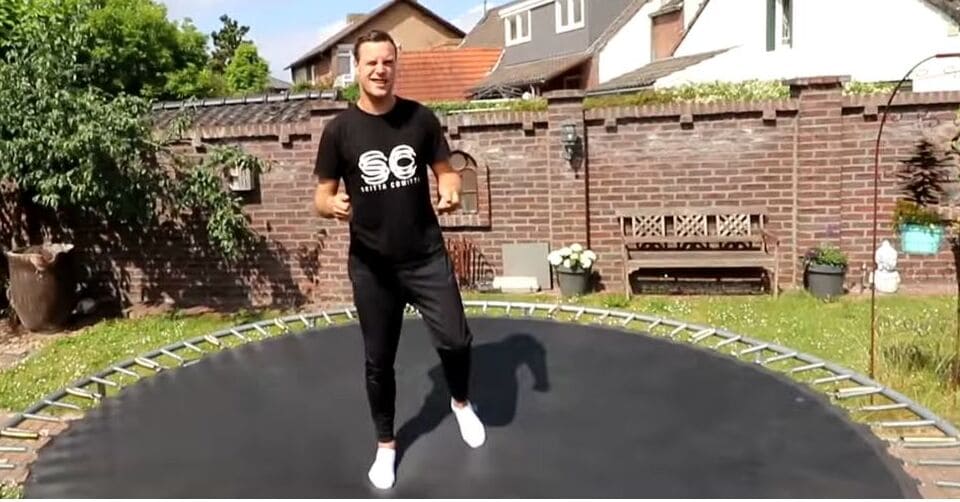
Regular mini trampoline exercises can help improve your self-esteem and confidence by promoting weight loss and improving your physical fitness.
These exercises can also provide a sense of accomplishment and mastery, which can boost your self-esteem and improve your overall sense of well-being.
Social connection
Mini trampoline exercises can be done alone or in a group setting, providing an opportunity for social connection and interaction. Joining a mini trampoline class or group can help you meet new people and form meaningful connections, which can improve your mental health and well-being.
Related article: Pros And Cons Of Trampoline Exercise
Mini Trampoline Exercises for Beginners
Mini trampoline exercises, also known as rebounding, are a fun and effective way to get in shape. Whether you’re a beginner or an experienced fitness enthusiast, there are a variety of exercises you can do on a mini trampoline to improve your cardiovascular fitness, strength, and balance.
we’ll discuss some mini trampoline exercises that are suitable for beginners, along with step-by-step instructions on how to perform each exercise safely and effectively.
Before we get started, it’s important to note that safety is key when it comes to mini trampoline exercises. Make sure your trampoline is in good condition and that you have enough space to exercise without hitting any nearby objects.
Wear comfortable, supportive shoes and clothing, and always warm up before exercising. Start with low-impact exercises and gradually increase the intensity and duration of your workout over time. And if you have any medical conditions or concerns, be sure to consult with your healthcare provider before starting any new exercise program.
Now, let’s take a look at some mini trampoline exercises that are perfect for beginners:
Basic Bounce
The basic bounce is a simple yet effective exercise that can help improve your cardiovascular fitness and coordination.
Instructions:
- Stand in the center of the trampoline with your feet hip-width apart.
- Keep your core engaged and your arms at your sides.
- Begin bouncing lightly on the balls of your feet, keeping your knees slightly bent.
- As you bounce, engage your core and focus on keeping your balance.
- Continue bouncing for 1-2 minutes, gradually increasing the intensity as you feel more comfortable.
Safety tips:
- Keep your feet and knees pointed straight ahead to avoid twisting your joints.
- Keep your movements small and controlled to reduce the risk of injury.
- Avoid bouncing too high or too fast, as this can increase the risk of injury.
Light Bounce
The light bounce is a low-impact exercise that can help improve your balance, coordination, and lower body strength.
Instructions:
- Stand in the center of the trampoline with your feet hip-width apart.
- Keep your core engaged and your arms at your sides.
- Begin bouncing lightly on the balls of your feet, lifting your heels slightly off the trampoline.
- As you bounce, focus on keeping your balance and engaging your leg muscles.
- Continue bouncing for 1-2 minutes, gradually increasing the intensity as you feel more comfortable.
Safety tips:
- Keep your movements controlled and avoid bouncing too high.
- Keep your feet and knees pointed straight ahead to avoid twisting your joints.
- Avoid leaning forward or backward, as this can throw off your balance.
Marching Bounce
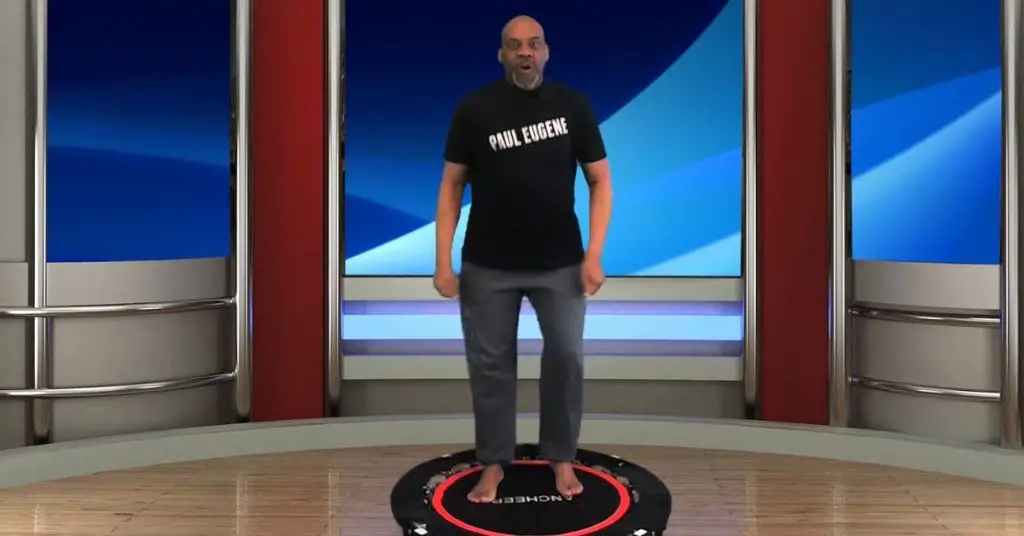
The marching bounce is a low-impact exercise that can help improve your cardiovascular fitness, leg strength, and coordination.
Instructions:
- Stand in the center of the trampoline with your feet hip-width apart.
- Keep your core engaged and your arms at your sides.
- Begin bouncing lightly on the balls of your feet, lifting your knees up to waist height as you bounce.
- As you bounce, focus on keeping your balance and engaging your leg muscles.
- Continue bouncing and marching for 1-2 minutes, gradually increasing the intensity as you feel more comfortable.
Safety tips:
- Keep your movements controlled and avoid bouncing too high.
- Keep your knees pointed straight ahead to avoid twisting your joints.
- Avoid leaning forward or backward, as this can throw off your balance.
Squat Bounce
The squat bounce is a low-impact exercise that can help improve your leg strength, balance, and coordination.
Instructions:
- Stand in the center of the trampoline with your feet hip-width apart.
- Lower your body into a squat position, keeping your knees behind your toes.
- From the squat position, begin bouncing on the trampoline, pushing off the trampoline with your feet, and extending your legs as you bounce.
- As you bounce, focus on keeping your balance and engaging your leg muscles.
- Continue squatting and bouncing for 1-2 minutes, gradually increasing the intensity as you feel more comfortable.
Safety tips:
- Keep your knees behind your toes to avoid straining your joints.
- Keep your movements controlled and avoid bouncing too high.
- Avoid leaning forward or backward, as this can throw off your balance.
Side-to-Side Bounce
The side-to-side bounce is a low-impact exercise that can help improve your coordination, balance, and core strength.
Instructions:
- Stand in the center of the trampoline with your feet hip-width apart.
- Begin bouncing lightly on the balls of your feet, shifting your weight from side to side as you bounce.
- As you bounce, focus on keeping your balance and engaging your core muscles.
- Continue bouncing from side to side for 1-2 minutes, gradually increasing the intensity as you feel more comfortable.
Safety tips:
- Keep your movements controlled and avoid bouncing too high.
- Keep your feet and knees pointed straight ahead to avoid twisting your joints.
- Avoid leaning too far to one side, as this can throw off your balance.
Intermediate and Advanced Mini Trampoline Exercises
If you’ve been using a mini trampoline for a while and feel comfortable with the basic exercises, you may be ready to take your workout to the next level.
The following exercises are suitable for intermediate and advanced users and can help improve your cardiovascular fitness, strength, and agility.
Jump Squats
Jump squats are high-impact exercises that can help improve your lower body strength, power, and explosiveness.
Instructions:
- Start by standing in the center of the trampoline with your feet shoulder-width apart.
- Lower your body into a squat position, keeping your back straight and your knees behind your toes.
- As you come up from the squat, jump as high as you can, pushing off the trampoline with your feet.
- Land softly on the trampoline, absorbing the impact with your leg muscles.
- Repeat for 10-15 repetitions, or for a set amount of time.
Safety tips:
- Make sure you have enough space around you to jump safely.
- Land softly on the trampoline to avoid joint pain or injury.
- Keep your movements controlled and avoid bouncing too high to maintain your balance.
Single Leg Hops
Single-leg hops are a challenging exercise that can help improve your balance, coordination, and lower body strength.
Instructions:
- Start by standing in the center of the trampoline with your left foot on the trampoline and your right foot off the trampoline.
- Bend your left knee and hop on your left foot, while keeping your right foot off the trampoline.
- Land softly on your left foot, and repeat for 10-15 repetitions.
- Switch to your right foot and repeat for 10-15 repetitions.
Safety tips:
- Make sure you have enough space around you to hop safely.
- Land softly on the trampoline to avoid joint pain or injury.
- Keep your movements controlled and avoid bouncing too high to maintain your balance.
Tuck Jumps
Tuck jumps are a challenging exercise that can help improve your lower body strength, power, and explosiveness.
Instructions:
- Start by standing in the center of the trampoline with your feet shoulder-width apart.
- Lower your body into a squat position, keeping your back straight and your knees behind your toes.
- As you come up from the squat, jump as high as you can, pulling your knees up to your chest.
- Land softly on the trampoline, absorbing the impact with your leg muscles.
- Repeat for 10-15 repetitions, or for a set amount of time.
Safety tips:
- Make sure you have enough space around you to jump safely.
- Land softly on the trampoline to avoid joint pain or injury.
- Keep your movements controlled and avoid bouncing too high to maintain your balance.
Alternating Single-Leg Jumps
Alternating single-leg jumps are a challenging exercise that can help improve your balance, coordination, and lower body strength.
Instructions:
- Start by standing in the center of the trampoline with your left foot on the trampoline and your right foot off the trampoline.
- Hop on your left foot, then switch to your right foot, alternating legs for 10-15 repetitions.
- Land softly on the trampoline to avoid joint pain or injury.
Safety tips:
- Make sure you have enough space around you to hop safely.
- Land softly on the trampoline to avoid joint pain or injury.
- Keep your movements controlled and avoid bouncing too high to maintain your balance.
Plyometric Lunges
Plyometric lunges are a high-impact exercise that can help improve your lower body strength, power, and agility.
Instructions:
- Start by standing in the center of the trampoline with your feet shoulder-width apart.
- Step forward with your left foot, lowering your body into a lunge position, keeping your back straight and your knee behind your toe.
- Push off the trampoline with your left foot, jump into the air, and switch your legs, so your right foot is now in front.
- Land softly on the trampoline, lowering your body back into a lunge position with your right foot in front.
- Repeat for 10-15 repetitions on each leg.
Safety tips:
- Make sure you have enough space around you to jump safely.
- Land softly on the trampoline to avoid joint pain or injury.
- Keep your movements controlled and avoid bouncing too high to maintain your balance.
Toe Taps
Toe taps are a low-impact exercise that can help improve your cardiovascular fitness and coordination.
Instructions:
- Start by standing in the center of the trampoline with your feet together.
- Tap your left foot on the trampoline, then quickly switch to your right foot.
- Continue alternating your feet for 30 seconds to 1 minute.
Safety tips:
- Keep your movements controlled and avoid bouncing too high to maintain your balance.
- If you feel unsteady, you can hold onto the frame of the trampoline for support.
Cross Jacks
Cross jacks are low-impact exercises that can help improve your cardiovascular fitness and coordination.
Instructions:
- Start by standing in the center of the trampoline with your feet together.
- Jump your feet apart, crossing your left foot in front of your right foot.
- Jump your feet back together, then jump your feet apart again, crossing your right foot in front of your left foot.
- Continue alternating your feet for 30 seconds to 1 minute.
Safety tips:
- Keep your movements controlled and avoid bouncing too high to maintain your balance.
- If you feel unsteady, you can hold onto the frame of the trampoline for support.
- Safety Tips for Intermediate and Advanced Users
When performing intermediate and advanced exercises on a mini trampoline, it’s important to follow these safety tips and precautions to reduce the risk of injury:
- Always warm up before your workout by performing some light cardio exercises, such as jumping jacks or jogging in place.
- Start with the easiest exercises and gradually work your way up to more challenging exercises as your strength and endurance improve.
- Make sure you have enough space around you to jump safely and clear the area of any obstacles or hazards.
- Land softly on the trampoline to reduce the impact on your joints, and avoid bouncing too high to maintain your balance.
- If you feel unsteady or lose your balance, step off the trampoline and take a break.
- Wear comfortable, supportive shoes to reduce the risk of foot and ankle injuries.
- Stay hydrated throughout your workout by drinking plenty of water.
Targeted Mini Trampoline Exercises
Mini trampoline exercises are not only great for improving cardiovascular health and overall fitness, but they can also be targeted to specific muscle groups and conditions. One such condition is lymphedema, a swelling of the arms or legs that can occur after cancer treatment.
we will discuss how mini trampoline exercises can target specific muscle groups and help with lymphedema. We will also provide a list of targeted exercises with step-by-step instructions on how to perform each exercise.
How Mini Trampoline Exercises Can Target Specific Muscle Groups
Mini trampoline exercises are great for targeting specific muscle groups because they offer a low-impact, high-intensity workout that can be easily adjusted to fit your fitness level and goals.
Here are some ways mini trampoline exercises can target specific muscle groups:
Plyometric exercises:
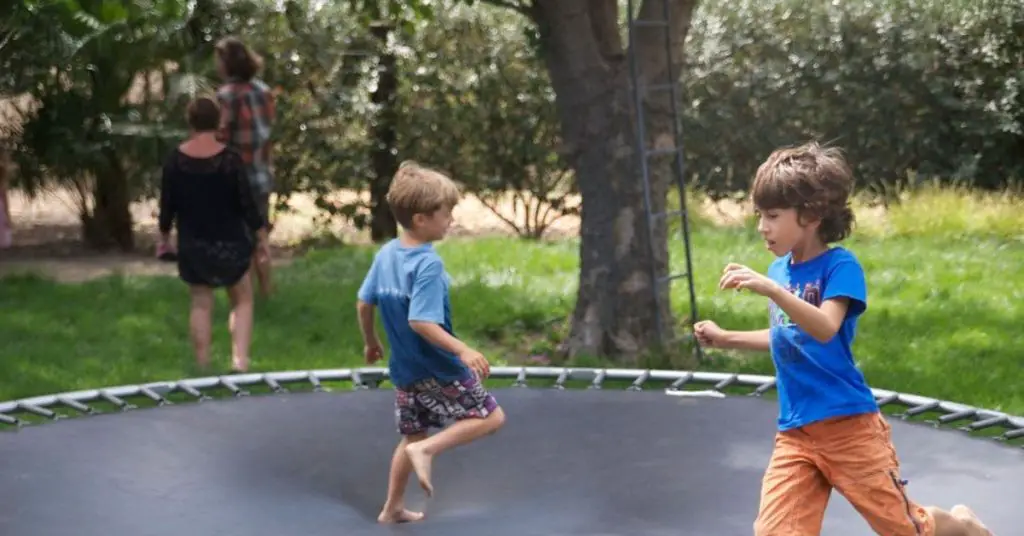
Plyometric exercises, such as jump squats and tuck jumps, are great for targeting the lower body, including the glutes, hamstrings, and calves. These exercises involve explosive movements that require a lot of power and strength.
Upper body exercises:
Mini trampoline exercises can also be used to target the upper body, including the arms, shoulders, and back. Exercises such as trampoline push-ups and trampoline dips can help strengthen these muscles.
Core exercises:
The core muscles, including the abs, obliques, and lower back, can be targeted with exercises such as jumping ab twists and plank jacks.
Balance exercises:
Mini trampoline exercises can also help improve balance and coordination, which are important for overall fitness and injury prevention. Exercises such as single-leg hops and lateral jumps can help improve balance and stability.
Targeted Mini Trampoline Exercises for Lymphedema
Mini trampoline exercises can also be used to help manage lymphedema, a condition that causes swelling in the arms or legs.
Here are some targeted exercises that can help with lymphedema:
Running Man Plyos:
This exercise targets the lower body, specifically the glutes, and calves.
Instructions:
- Stand on the mini trampoline with your feet hip-width apart.
- Lift your left leg, bending your knee and bringing it up towards your chest.
- Jump off your right foot and switch legs mid-air, bringing your right knee up towards your chest and your left foot back to the trampoline.
- Land softly on your right foot, then immediately jump off your left foot and switch legs again.
- Continue alternating legs for 30 seconds to 1 minute.
Safety tips:
- Keep your movements controlled and avoid bouncing too high to maintain your balance.
- If you feel unsteady, you can hold onto the frame of the trampoline for support.
Jumping Ab Twists:
This exercise targets the core muscles, including the abs and obliques.
Instructions:
- Stand on the mini trampoline with your feet hip-width apart.
- Jump and twist your lower body to the left, bringing your knees up towards your chest and twisting your torso to the left.
- Land softly on the trampoline, then jump and twist to the right, bringing your knees up towards your chest and twisting your torso to the right.
- Continue alternating sides for 30 seconds to 1 minute.
Safety tips:
Keep your movements controlled and avoid bouncing too high to maintain your balance.
If you feel unsteady, you can hold onto the frame of the trampoline for support.
Trampoline Dips:
This exercise targets the triceps, chest, and shoulders.
Instructions:
- Sit on the edge of the mini trampoline with your hands on the trampoline behind you.
- Walk your feet out in front of you until your legs are straight.
- Lower your body towards the ground by bending your elbows, keeping your back straight.
- Push back up to the starting position and repeat for 10-15 repetitions.
Safety tips:
- Keep your back straight and avoid arching it.
- Keep your elbows close to your body to engage your triceps.
- If you have any shoulder or elbow pain, avoid this exercise or modify it by using a chair or bench for support.
Single-Leg Hops:
This exercise targets the lower body, specifically the glutes, and calves, while also improving balance and coordination.
Instructions:
- Stand on the mini trampoline with your feet hip-width apart.
- Lift your left foot off the trampoline and balance on your right foot.
- Hop on your right foot for 10-15 repetitions, then switch to your left foot and hop for another 10-15 repetitions.
- Repeat for 30 seconds to 1 minute.
Safety tips:
- Keep your movements controlled and avoid bouncing too high to maintain your balance.
- If you feel unsteady, you can hold onto the frame of the trampoline for support.
Designing a Mini Trampoline Workout Plan
Mini trampoline workouts can be a fun and effective way to improve your cardiovascular health, strengthen your muscles, and burn calories.
However, it is important to design a workout plan that is safe, effective, and tailored to your fitness level and goals. Here are some tips on how to design a mini trampoline workout plan:
Determine your fitness level and goals
Before designing your workout plan, it is important to determine your current fitness level and goals. Are you a beginner, intermediate, or advanced exerciser? What do you want to achieve with your workouts, such as weight loss, increased endurance, or muscle toning?
Understanding your fitness level and goals will help you select the appropriate exercises and set realistic expectations for your progress.
Choose your exercises
Once you have determined your fitness level and goals, you can select the exercises that will help you achieve them. Start with basic exercises if you are a beginner, and gradually increase the intensity and complexity of your workouts as you become more comfortable with the exercises.
Include a variety of exercises that target different muscle groups and incorporate both cardio and strength training. You can refer to the lists of beginner, intermediate, and advanced exercises in the previous sections for ideas.
Determine your workout frequency and duration
Decide how often you will work out and for how long. The American Heart Association recommends at least 150 minutes of moderate-intensity aerobic activity or 75 minutes of vigorous-intensity aerobic activity per week for adults.
You can break this down into shorter workouts throughout the week, such as 30 minutes per day, five days per week. Gradually increase the duration and intensity of your workouts as you become more fit.
Warm up and cool down
It is important to warm up before starting any workout to prevent injury and prepare your body for exercise. A simple warm-up routine can include light bouncing, marching in place, and stretching. Start with low intensity and gradually increase the intensity and duration of your warm-up.
Similarly, it is important to cool down after a workout to lower your heart rate, prevent dizziness, and reduce muscle soreness.
A cool-down routine can include light bouncing, stretching, and deep breathing. Gradually decrease the intensity and duration of your workout during your cool-down.
Monitor your progress
Track your progress to see how far you have come and make adjustments to your workout plan as needed. Keep a record of your workouts, including the exercises, duration, and intensity.
You can also track your weight, body measurements, and fitness level. Use this information to adjust your workout plan and set new goals for yourself.
Maintenance and Care of the Mini Trampoline
Maintenance and care of a mini trampoline are essential to ensure its longevity, safety, and optimal performance. Regular maintenance will help prevent accidents and injuries while preserving the bounce quality.
Here are some tips on how to properly maintain and care for your mini trampoline:
Regular Cleaning:
Clean the surface of the trampoline regularly to remove dust, dirt, and sweat. Use a mild soap and water solution to wipe down the mat and frame. Avoid using harsh chemicals that may damage the trampoline material.
Check for Wear and Tear:
Inspect the mat, springs, and frame for any signs of wear and tear. Look for frayed edges, tears, or loose parts. If you notice any damage, repair or replace the affected components promptly.
Tighten Screws and Bolts:
Regularly check and tighten all screws, bolts, and connections. The vibrations during exercises may cause them to loosen over time.
Store Indoors:
Store the mini trampoline indoors when not in use. Exposure to the elements, especially sunlight, and rain, can lead to premature degradation of the mat and frame.
Use Proper Footwear:
Encourage users to wear appropriate footwear, such as athletic shoes with good grip, while exercising on the trampoline. Bare feet may cause excessive wear on the mat and reduce its lifespan.
Weight Limit:
Be mindful of the weight capacity of the mini trampoline. Avoid exceeding the specified weight limit, as this may lead to damage and compromise safety.
Avoid Sharp Objects:
Keep sharp objects away from the trampoline to prevent punctures or tears in the mat.
Supervise Children:
If children are using the mini trampoline, always supervise them to ensure they use it safely and follow proper guidelines.
Rotate Springs:
If your mini trampoline has removable springs, consider rotating them periodically. This practice can help distribute wear more evenly among the springs.
Replace Worn-out Parts:
If any components of the trampoline, such as the mat or springs, show significant signs of wear or damage, it’s essential to replace them promptly with compatible and high-quality replacement parts.
Follow the Manufacturer’s Instructions:
Always follow the maintenance guidelines provided by the manufacturer. Each trampoline may have specific care requirements based on its design and materials.
Regular maintenance and care will not only extend the life of your mini trampoline but also ensure a safe and enjoyable exercise experience for users of all ages. By taking the time to properly care for your mini trampoline, you can continue to enjoy its benefits for years to come.
FAQs:
Q.1 What are mini trampoline exercises, and what are their benefits?
Mini trampoline exercises, also known as rebounding, involve performing a variety of low-impact exercises on a small trampoline. These exercises offer a range of physical and mental health benefits, including improved cardiovascular health, weight loss, stress reduction, and increased lymphatic drainage.
Q.2 Can mini trampoline exercises be done by beginners?
Yes, mini trampoline exercises can be done by beginners. There are a variety of exercises suitable for beginners, such as basic bounce, light bounce, and marching bounce. It’s important to start slowly and gradually increase the intensity of the workout.
Q.3 What are the safety precautions to keep in mind while doing mini trampoline exercises?
Some safety precautions to keep in mind while doing mini trampoline exercises include wearing supportive shoes, avoiding high-impact exercises, and making sure the trampoline is placed on a flat, stable surface. It’s also important to warm up before starting the workout and cool down after the workout.
Q.4 Can mini trampoline exercises target specific muscle groups?
Yes, mini trampoline exercises can target specific muscle groups, such as the legs, core, and arms. There are a variety of targeted exercises, such as running man plyos and jumping ab twists, that can be incorporated into a workout plan.
Q.5 How do I design a workout plan using mini trampoline exercises?
To design a workout plan using mini trampoline exercises, it’s important to start with a warm-up, incorporate a variety of exercises that target different muscle groups, and end with a cool down. It’s also important to gradually increase the intensity of the workout and incorporate rest days to allow the body to recover.
Conclusion:
In conclusion, mini trampoline exercises offer a fun and effective way to improve physical and mental health for people of all fitness levels. There are different types of mini trampolines available, each with its own unique features.
The benefits of mini trampoline exercises include weight loss, improved cardiovascular health, increased strength and endurance, reduced joint pain, and improved lymphatic system function.
Additionally, mini trampoline exercises can reduce stress, increase energy and focus, improve self-esteem, and provide social connection.
Beginners can start with basic exercises such as the Basic Bounce, Light Bounce, and Marching Bounce, while intermediate and advanced users can try more challenging exercises such as Tuck Jumps and Plyometric Lunges.
Targeted exercises can also be designed to target specific muscle groups or address conditions like lymphedema.
When designing a mini trampoline workout plan, it’s important to determine your fitness level and goals, choose your exercises, determine your workout frequency and duration, and include warm-up and cool-down periods. Monitoring your progress can help you adjust your plan accordingly and achieve your fitness goals.
After reading this complete guide about Mini trampoline exercises, we hope that you have gained enough knowledge and understanding about it. If you have any questions, please feel free to ask us in the comments section below.

